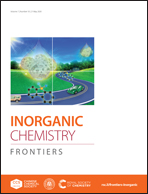Highly efficient and stable CsPbBr3 perovskite quantum dots by encapsulation in dual-shell hollow silica spheres for WLEDs†
Abstract
Poor stability of CsPbX3 (X = Cl, Br or I) perovskite quantum dots (QDs) has greatly hindered their practical photoelectric applications, and how to improve it still remains a critical challenge. Herein, we encapsulated CsPbBr3 QDs into dual-shell hollow silica (SiO2) spheres via a simple successive ionic layer adsorption and reaction (SILAR) method. The hierarchical dual-shell structures permit CsPbBr3 QDs to be anchored on the interior of the SiO2 spheres while keeping the outside surface undisturbed, which can protect the CsPbBr3 QDs from direct exposure to the atmosphere. Due to the comprehensive protection of dual-shell hollow SiO2 spheres, the CsPbBr3/SiO2 nanospheres exhibit markedly enhanced stability against light and heat, with a residual PL intensity of 89% after continuous exposure for 72 h to UV light and 65% after 100 °C heat treatment, respectively. In addition, an optimal PLQY of 89% is obtained with suppressed nonradiative recombination. Finally, the fabricated white light-emitting diode (LED) device by employing CsPbBr3/SiO2 green phosphors could achieve a wide color gamut covering up to 136% of the NTSC standard. This work provides a novel SiO2-based encapsulation approach to solve the intrinsic instability issues of CsPbBr3 QDs, which has a profound impact on their practical applications.



 Please wait while we load your content...
Please wait while we load your content...